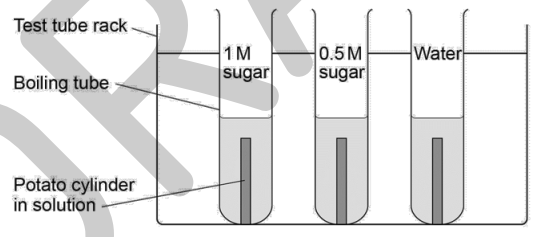Investigating osmosis in potato tissue
Osmosis is the movement of water through a selectively permeable membrane from an area of high concentration of water to an area of lower concentration of water. Plant tissues, such as potato, can be used to investigate osmosis. In this experiment potatoes are cut into equal sized cylinders. The changes in length and mass after leaving them overnight in sugar solution and distilled water can then be accurately compared.
EQUIPMENT
1) Using a cork borer, cut three potato cylinders of the same diameter.
2) Trim the cylinders so that they are all the same length (about 3 cm).
3) Accurately measure and record the length and mass of each potato cylinder.
4) Measure out 10 cm3 of the 1 M sugar solution and place into the first boiling tube (labelled 1 M sugar).
5) Measure out 10 cm3 of 0.5 M sugar solution and place into the second boiling tube (labelled 0.5 M sugar).
6) Measure out 10 cm3 of the distilled water into the third boiling tube (labelled water).
7) Add one potato cylinder to each tube (make sure you know which one is which in terms of the length and mass).

8) Record your lengths and masses in a table such as the one below.
9) Leave the potato cylinders in the boiling tubes overnight in the test tube rack.
10) Remove the cylinders from the boiling tubes and carefully blot them dry with the paper towels.
11) Re-measure the length and mass of each cylinder (make sure you know which is which).

12) Draw a graph with ‘Change in mass in g’ on the y-axis against ‘Concentration of sugar solution’ on the x-axis.
60 Copyright © 2015 AQA and its licensors. All rights reserved.
 Note
Note Studied by 16 people
Studied by 16 people Note
Note Studied by 5 people
Studied by 5 people Note
Note Studied by 19 people
Studied by 19 people Note
Note Studied by 18 people
Studied by 18 people Note
Note Studied by 20 people
Studied by 20 people Note
Note Studied by 14 people
Studied by 14 people Knowt
Knowt
